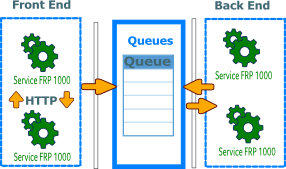MOM architecture (Cloud)
De Wiki1000
(Différences entre les versions)
(→Asynchronous operations) |
|||
| Ligne 6 : | Ligne 6 : | ||
===Asynchronous operations=== | ===Asynchronous operations=== | ||
| + | When the MOM architecture is used, the front services execute user actions as asynchronous tasks. | ||
| + | |||
| + | The user action concerned are : | ||
| + | |||
| + | * Application processes which can be scheduled. | ||
| + | * Printing and preview. | ||
| + | * Exporting. | ||
| + | |||
| + | Depending of the user task nature, the asynchronous aspect of the execution may be transparent or not : | ||
| + | |||
| + | * When an action is executed as a transparent asynchronous task, the user has immediately the result. | ||
| + | * When an action is executed as a not transparent asynchronous task, the user as the result in his message box and is notified in the interface of the execution status. | ||
| + | |||
| + | Because transparent asynchronous task require a minimum latency, the queue used for these tasks is separate and listeners used a shorter polling rate. | ||
===Queues=== | ===Queues=== | ||
Version du 27 février 2017 à 10:40
Overview
Because Sage FRP 1000 Cloud solution is based on the concept of separation of a front and back roles, communicating by messages, a new MOM architecture has been developed to implement this concept.
Asynchronous operations
When the MOM architecture is used, the front services execute user actions as asynchronous tasks.
The user action concerned are :
- Application processes which can be scheduled.
- Printing and preview.
- Exporting.
Depending of the user task nature, the asynchronous aspect of the execution may be transparent or not :
- When an action is executed as a transparent asynchronous task, the user has immediately the result.
- When an action is executed as a not transparent asynchronous task, the user as the result in his message box and is notified in the interface of the execution status.
Because transparent asynchronous task require a minimum latency, the queue used for these tasks is separate and listeners used a shorter polling rate.
Queues
| Whos here now: Members 0 Guests 0 Bots & Crawlers 1 |
